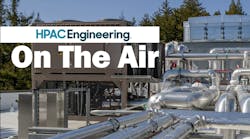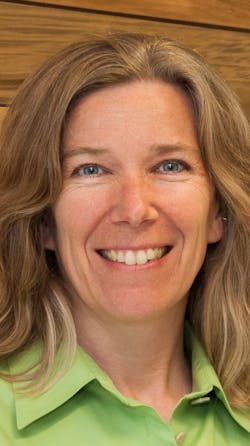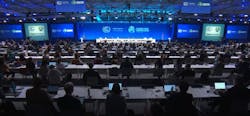HPAC 'On The Air': Report from COP26, with USGBC's Liz Beardsley
"The younger generation is not going to let us off the hook!"
Just back from Scotland, our guest this month is Elizabeth Beardsley, senior policy counsel for the U.S. Green Building Council, which she represented last month at the 26th United Nations Climate Change Conference in Glasgow, or 'COP26', for short. A longtime environmental advocate, Liz holds a civil engineering degree from Stanford University and a law degree from the University of Virginia. She describes herself online as "a mom, daughter, friend, and lifelong earth lover."
- To read Beardsley's initial blog upon returning from COP26, click here.
Here, Liz expounds on several key COP26 takeaways and also highlights some important climate components contained in the new federal infrastructure funding. Please listen and share... (Below, a partial transcript, edited.)
HPAC On The Air: Liz, thanks so much for joining us. We feel privileged to be able to share your very fresh insights from COP26 with our audience, and last week we even posted your first wrap-up blog from the conference on our website, hpac.com. Could you please sum up some of those initial impressions for our readers? Had you been to any of the previous COP conferences?
Liz Beardsley: Thank you, Rob. It's a pleasure to be here. And yes, that's a great place to start. I had actually been to COP21 in Paris. That was my first one and that's, of course, where the Paris Agreement was formed. So, it was really an exciting time. And COP21 was the very first time there was a "Buildings Day"... To describe the conference, I'll do my best here.Part of it is the actual negotiations, where the countries, or "parties" to the framework agreement, meet every year to try to make progress with additional details, changing the terms, if needed, and having detailed negotiations, by article. Then there's also additional, behind-the-scenes negotiations that might go on between two countries, or groups of countries. And that's where there are different coalitions that form... Also, if you're not part of a country delegation, you might be observing, and there are some NGOs that really do get in the weeds re specific things that they want to see in the agreement. So they will work with the parties to try to accomplish those goals and influence those outcomes... And just observe and report out to interested stakeholders.
Part of the COP is also just like a conference, so it was interesting to see how that has evolved over the last five years. There are pavilions that countries have, and depending on the country, they might showcase their technologies and solutions, or the science, or the impact that climate change is having on that country.
So, you can imagine roaming the pavilions and seeing that diversity and all the focus around the globe, all on climate, from different angles. Whether it's on rising sea levels, or droughts causing agricultural problems, it really put things in perspective how real this situation is. And then there were side events where there were presentations, and panel discussions, and so on, on a full range of climate topics. And that's one of the things that we do at the COP: make presentations and participate.
This year, there were probably more local governments and state governments than there were before. So that was really a positive. And overall, I would say that the trend was more toward solutions. There are some countries that are really quite vulnerable, so they were showing what is happening there now.
Overall impression for me was just the very sobering reality of where we are. Just a couple weeks before the COP, the International Energy Agency released its assessment of where things stood, based on all the climate commitments that had already been made by nations. It found that they would still bring global temperatures up by more than 2.5 degrees! But since COP happens every year, it is also forcing event that brings with it a lot of new commitments, especially in that first week of the conference. And there was an assessment there that all those new commitments might bring us closer to about 1.7 degrees of warming.
But that still depends on everything in a commitment getting done. And that's one of our concerns. We see commitments being made, and that is progress, in and of itself. But now we really have to see the action and accountability across the board, from the country level to businesses that are making commitments. We have to be able to see that change happen through data, over time, and we need to accelerate our actions, as well.
HPAC: As for takeaways, much has been made about the inability of the largest nations to agree on truly urgent action to mitigate global climate change. Some have even called COP26 a "cop-out". Beforehand, many had referred to this event as the "last best hope" to change the planet's trajectory. How do you assess the success and impact of the summit?
Beardsley: Well, I'm more of an optimist, "glass half-full" person, by nature, I guess. And I think that would dictate someone's response to that question because there was a mix. The positives were that we did see that flurry of enhanced commitments come out. Also, the youth voice was really strong, mostly outside the fence line. I think it was palpable. I know that's hard to define, but I think it was there. And some of the negotiators were bringing photos of their grandchildren and bringing up future generations. That was more and more common. As I said, those commitments need to be followed up on now. But once they are, in a given strategy or sector, then I think that can create momentum.
I mean, I remember as a kid, hearing my dad talk about solar energy, and it seemed so crazy. And it seemed crazy for the longest time, until all of a sudden, it seemed like the coolest thing, and 'Why can't I have it on my house?' So, flip to where solar and wind (energy) are now lower cost for new production than fossil fuels are in the U.S. now. It just took a while to get there.
Another big takeaway was a focus on the next 10 years as being critical, so that we don't lock in more carbon and we preserve the chance to keep global warming to less than 1.5 degrees. That's a really important recognition for us. And getting started is better than not getting started. So I think that was an overall positive. The presence of business there was also important. The business community was pushing. They want more certainty, and more ambition. And I think that was another positive.
There were also some other specific breakthroughs that helped to make this summit have a positive impact. There was the Methane Pledge on the countries side. And on the business side, there was the Race to Zero (emissions) pledge, so there were a number of commitment platforms, and all of them seem to have 'zero' in the air somewhere... So more and more businesses now seem to want to make this part of their brand, and they seem really motivated to make changes.
The other big thing for the building sector and engineering was seeing the focus on embodied carbon and supply chains. That's been a really hard issue for companies, too. How do you get the data? You might care about how much energy is used to produce your concrete, or how much the carbon emissions are. But as one entity, you might not feel you can change that. But we saw that the U.S. was a leader, along with the E.U., in forming the first mover's coalition which brings together corporate buyers of materials, like steel and concrete, and manufacturers of those materials. That purchasing power sends a signal to the manufacturers that they can still invest in these processes without losing their competitve advantage. They will still have buyers for their products even though they may cost a little bit more.
HPAC: Looking ahead in the U.S., please talk a bit about what this month's passage of our nation's long-overdue infrastructure investment package will mean to the future of green building.
Beardsley: We'd been working on these bills for some time now, since back in 2020 when it was clear that there was goung to be some reinvestment in the economy as a result of the pandemic. We started talking then about building efficiency as an important area for jobs, and for helping to meet some of our climate goals, and all the other co-benefits of saving consumers money and improving businesses' competitiveness, and so on. And now the infrastructure bill is law, which is great. Some of the things in there include our program with the Dept. of Energy to help fund lower-wealth, higher-need school districts with energy-efficiency and renewable energy projects. There are also some funds in there for weatherization and for state energy programs. And then there's monies for more tradional infrastructure like airports, but include a priority for projects that improve energy efficiency and sustainability. So some of that language is really positive and will help get this money not just out there for traditional replacement and expansion projects, but also to make it more climate-friendly as an outcome.
HPAC: The U.S. House of Representatives also just passed the new Build Back Better bill, which still must go through the Senate. But there are more climate mitigation measures in there. Can you speak to that a bit?
Beardsley: The reconciliation bill we know will see some size haircut in the Senate. We don't know yet what that trim will look like. And that one is most definitely not bipartisan. It's a Democratic endeavor using the specific budget process of reconcilitaion. It includes much more, such as legislation for federal buildings, to do renovations that make them high-performing green buildings; money to help build resilience and to use procurement to invest in cleaner materials and products, which could include electrification, as well. There's also some tax incentives for clean energy, including some updates to something your audience is very familiar with, the 179-D Commercial Buildings Energy-Efficient Property Deduction, as well as 45-L for New Residential Construction, and 25-C, for retrofit components, and retrofits of housing. So, there's a lot there, and we hope monies ultimately will be used to help optimize outcomes and build momentum for more and more changes in the building sector, and getting deeper efficiencies much more commonplace.
HPAC: Finally, we also spoke to USGBC co-founder Rick Fedrizzi earlier this year, and I will ask you the same question that I asked him... Today, taking real action on the climate ironically faces obstacles from two diametrically opposed factions: those who somehow still deny that climate change is real; and those who acknowledge that it is, but say it is already too late to make a difference, the Eeyores of the movement. As a "mom, daughter, friend, and lifelong earth lover", what do you say to friends, colleagues, legislators and business leaders who express either of those views?
Beardsley: That's an interesting question. There are people like that out there. But I feel like when you talk to someone one-on-one, or in smaller groups, there is a lot less of that. So I feel like, in the U.S. especially, it really comes down to change. People are just really afraid of change. So I don't really even know if that is so much idealogically-based as much as it is just a fear of the unknown. People think of it in a very personal way, i.e., 'If we transition to clean energy, does that mean that we can't go on vacation because we're not supposed to fly? Or does it mean we have to have a smaller house? Or how will it affect my job?'
To answer that question more directly, I recently attended a dinner sponsored by the Conservative Climate Caucus. So there were some conservative lawmakers there and I spoke with Congressman John Curtis from Carbon County, Utah. We spoke about conversations he has had with coal-miners in his district, essentially saying that, 'You know, these jobs are going to be gone and that mining is very good for you.' And he said that the miners understand that. In his words, he says that just want to have determination of what's next. They don't want to have Washington decide what they are going to be re-trained as... So, in the U.S., I think it's really more about options and freedom of personal choice, and how do we go about recognizing those traditions while recognizing that we have one Earth. We have one planet. So we really have to work together.
HPAC: You have referred to yourself previously as always being an optimistic person. Before Glasgow, after Glasgow... how would you rate your level of optimism now?
Beardsley: I think it's higher, actually. The youth pressure there was just really strong and effective. It was all very peaceful, but there were posters from children in the halls of the COP and all the negotiators were very aware of them. I just think the younger generation is not going to let us off the hook. They will keep that pressure up, and that will keep ambition up. But I think it is incumbent on our industry and our government to hold ourselves accountable, and do what we said we were going to do. And that's where I think 'Build Back Better' and infrastructure funding can be really helpful in building that momentum. And that's where things will take off, and then it will go faster than anyone predicted. As engineers know, I'm hoping it will be like technology adoption, where that curve just goes slow, slow, slow, and then everything just takes off.
##########
To listen to previous 'HPAC On The Air' podcasts, visit our Members Only page.
##########


